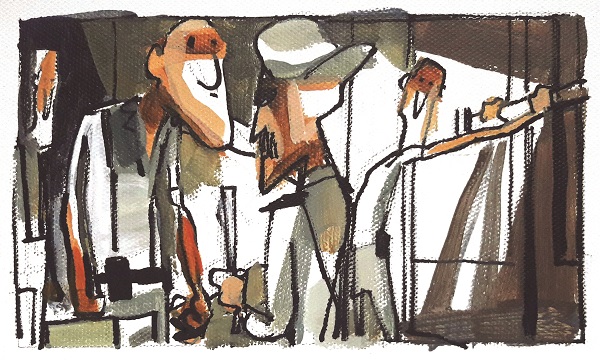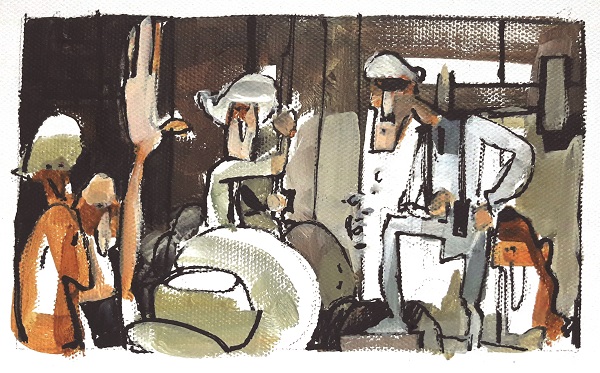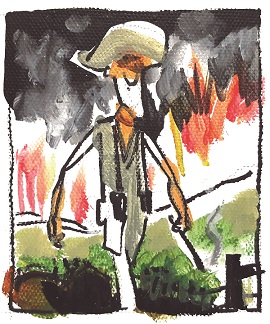- Home
- Staff
- Texto no traducido
- Las Cruces Rojas de los Últimos de Filipinas
I´ll tell you II
I´ll tell you II
The Red Crosses earned by the ‘Last Ones in the Philippines’
The series ‘Soldiers with red distinction’ from the Land newspaper is still under siege in Baler. I’ll tell you that getting out of there with honours was very difficult. Other detachments in the Philippines with more men did not manage it and surrendered in a number of days. But Baler was different. .
It is the 1st of September more than 120 years ago and the Tagalog insurgents are increasing the pressure on the siege with approaches which are comprised of trenches, shovels, ditches and access tunnels, but they don’t do it uncovered; instead they wait for the shelter offered to them by darkness. The Spanish soldiers stay alert and shoot into the night towards the noise coming from outside, always hidden by the crashing of the waves from the nearby sea, which comes in the silence of the night, helping the besiegers.
The siege encloses them with a sapper’s patience, who thinks he is the master of time, and, with this time, they make the trenches bigger until they are just 50 steps from the church, creating a very irregular contravallation line which is supported by the houses closest to the church, some on slopes. From here they fire – barely exposing themselves – at the Spanish soldiers, who in this situation are very vulnerable to enemy fire, whilst the insurgents, of which there are far more than the Spaniards, can shoot at the shelter from the long thin holes in the trenches which they have constructed above every home.

It’s the 1st of September. Faced with so much enemy fire, the situation is desperate, and Lieutenant Juan Alonso Zayas must make a desperate decision. He gathers all of his soldiers and, with a serious voice, explains that the siege is about to close in, that it has almost reached the Civil Guard’s headquarters, which is only 15 metres from the church, and he asks for a volunteer for what is a genuine suicide mission: “A man will go out with just a can of petrol and will have to burn the enemy defences from where they are shooting at us. If the siege continues, they’ll kill us all from just 10 metres away. We won’t be able to move. I need a volunteer.”
“A volunteer.” These words fly around the baptistery of the San Luis de Tolosa church in Baler, sharp and raw. Who’s going to answer? A young man from Osa de la Vega, Cuenca, answers them, a farm hand who at nine years old had to leave school in order to work, and who arrived in the Philippines two years prior, as part of the 2nd Expeditionary ‘Cazadores’ Battalion. Private Gregorio Catalán Valero steps forward and says: “I’ll go, Lieutenant.”

Lieutenant Zayas looks at him and, without beating around the bush, tells him that there are 800 men waiting for him outside who will try to make sure that he does not achieve his goal, but Gregorio does not hesitate and says that he will go out and try to fulfil his mission. And “Besides, Lieutenant, it’s better to be shot by 800 Tagalogs than to be shut in.” The Lieutenant embraces him and tells him to get ready.
It’s 2pm on the 2nd of September. In broad daylight, without the cover of darkness to protect him – the Spanish heroes in the Philippines were that brave – Gregorio Catalán crosses himself and leaves the church with a petrol can in one hand and a rod covered in rags over his shoulder. Under intense gunfire, which the Spaniards initiate to cover him, he approaches the headquarters of the Civil Guard and sets fire to the tinder, and the petrol soaked rags begin to burn. As the flames approach, the headquarters soon begin to burn intensely, stoked on by the palm leaves and wood.
Bullets pass close to Gregorio Catalán, but, although his only mission was to burn the headquarters, he decides to continue to the adjacent houses and calmly sets fire to three other buildings, which are burnt to the ground. The shots don’t kill him, since the insurgents had to risk the threat of being shot by the Spaniards who were protecting their comrade.
 Neither Lieutenant Zayas nor Lieutenant Martín Cerezo can believe what they are seeing: a soldier with a petrol can and a rod, receiving fire from hundreds of insurgents, calmly returns to the church without a scratch after burning down the enemy defences. After he crosses the entrance of the church, he smiles slightly as he sees his comrades’ joy. With this look he says to Lieutenant Zayas: “See, Lieutenant, better to be out than in.” Lieutenant Zayas asks if he is injured, and he replies no, and that they don’t have to talk about what happened: the smoke is proof enough of what took place.
Neither Lieutenant Zayas nor Lieutenant Martín Cerezo can believe what they are seeing: a soldier with a petrol can and a rod, receiving fire from hundreds of insurgents, calmly returns to the church without a scratch after burning down the enemy defences. After he crosses the entrance of the church, he smiles slightly as he sees his comrades’ joy. With this look he says to Lieutenant Zayas: “See, Lieutenant, better to be out than in.” Lieutenant Zayas asks if he is injured, and he replies no, and that they don’t have to talk about what happened: the smoke is proof enough of what took place.
With this action, the line of trenches was pushed backwards and the 60 days of the siege could continue to test the tenacity, strength of spirit and military training of that small contingent who took shelter in the church of San Luis de Tolosa.
Private Gregorio Catalán, after being received with honours along with his comrades upon his arrival in the port of Barcelona, returned to Cuenca, where he died two years later from tuberculosis and the suffering he experienced in the Philippines. He continues to be remembered in Osa de la Vega, with a statue of the young Gregorio carrying a can of petrol in one hand and a torch in the other. The generation to come must not forget about their heroes.
Terminology:
- Approaches: various techniques that were used to attack a position and approach it in order to defeat it, such as trenches, parallels, batteries, mines, etc..
- Contravallation line: a line formed by the besieging army to ensure that the besieged cannot escape.
- Circumvallation line: a line built at the rearguard of the besieging army to defend it from any enemy troops.
- Loophole: a long and thin opening in a wall through which a soldier can shoot.
ARMY UNITS
- Araba Álava |
- Albacete |
- Alicante |
- Almería |
- Asturias |
- Ávila |
- Badajoz |
- Barcelona |
- Burgos |
- Cáceres |
- Cádiz |
- Cantabria |
- Castellón |
- Ceuta |
- Ciudad Real |
- Córdoba |
- A Coruña |
- Cuenca |
- Girona |
- Granada |
- Guadalajara |
- Gipuzkoa |
- Huelva |
- Huesca |
- Islas Baleares |
- Jaén |
- León |
- Lleida |
- Lugo |
- Madrid |
- Málaga |
- Melilla |
- Murcia |
- Navarra |
- Ourense |
- Palencia |
- Las Palmas |
- Pontevedra |
- La Rioja |
- Salamanca |
- Segovia |
- Sevilla |
- Soria |
- Tarragona |
- Santa Cruz de Tenerife |
- Teruel |
- Toledo |
- Valencia |
- Valladolid |
- Bizkaia |
- Zamora |
- Zaragoza



